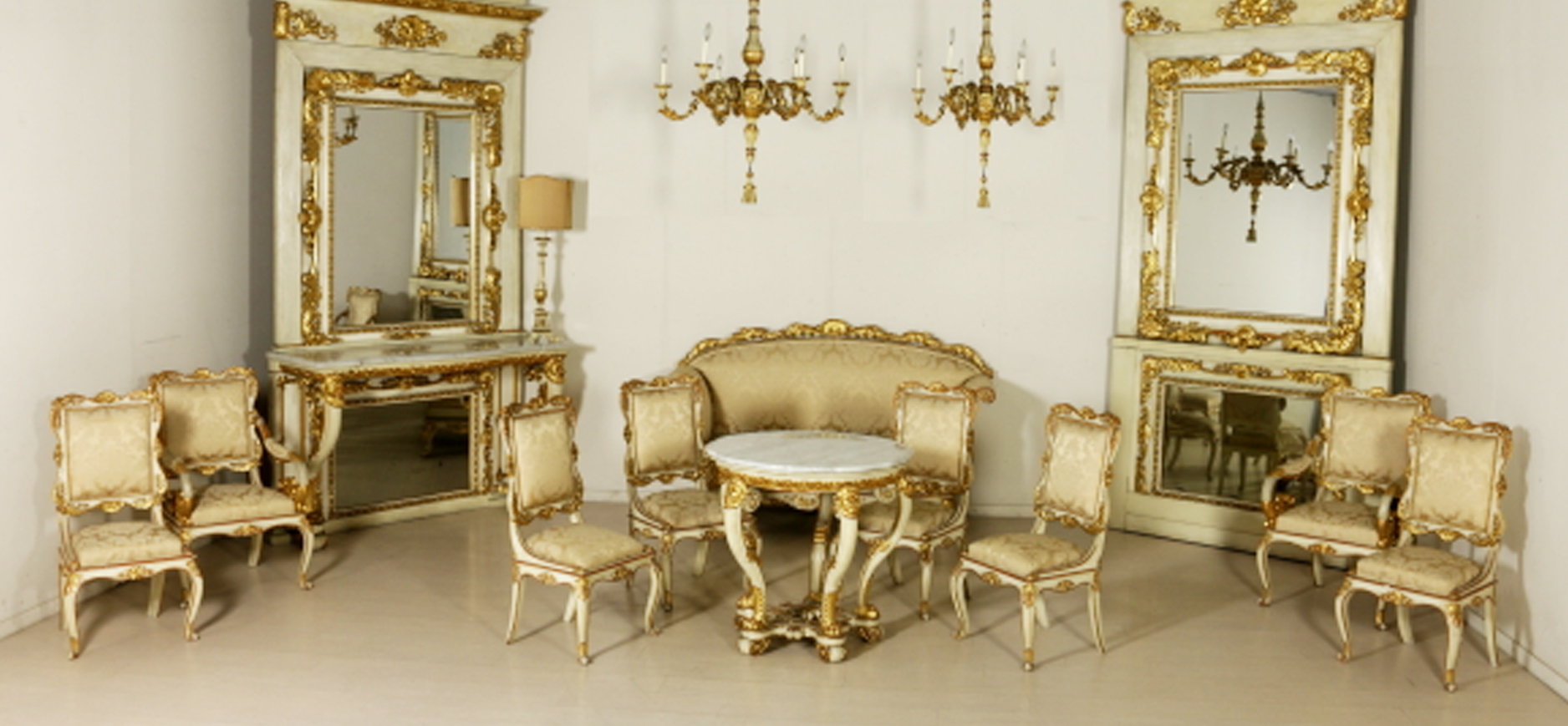The last Lombard Neoclassicism

A Brescia Living Room from the First Half of the 19th Century
The Last Lombard Neoclassicism: Influences of Domenico Moglia, the Works of Vantini in Collaboration with Foresti in the City of Brescia
As part of the annual edition of Antiquaria Solidale, we are pleased to present a living room suite from the mid-19th century originating from a Brescia palace.
It includes a console with a mirror accompanied by a similar back wall, a sofa, two armchairs, and a round table with six chairs. The furniture is lacquered in ivory with abundant carved and gilded parts, while the tops are made of white marble.
The main motifs featured are acanthus leaves adorning the backs of the seats, the gondola-shaped back of the sofa, and the frames of the mirrors; acanthus leaves also decorate the feet of the seats, as if they were little shoes.
The anthemion is another recurring vegetal motif in the carvings, prominently visible on the back legs of the tables and especially on the armrests of the armchairs, which elegantly curve to rest on the seat with an open corolla.
The carved legs of the table and console are particularly captivating: the former are curved and connected to the top with a mascaron, while the latter feature lion protomes, resting on bases with clawed feet adorned by acanthus leaves.
The forms alternate between the austerity and composure of a late Neoclassical style and the sinuosity and elegance of the Rococo movements evident in the seating.
A brief historical journey into the events that define and shape the Lombard Neoclassical taste and style will allow for a deeper and more careful analysis of this living room suite.
When the Habsburg court decided to assign the Governorship of Milan to Archduke Ferdinand (Schonbrunn 1754 – Vienna 1806), he entrusted the renovation of the Archducal Palace (1773) and the construction of the Royal Villa of Monza (1777) to Giuseppe Piermarini (Foligno 1734 – 1808).
The great architect was supported in decorating the palaces by Giocondo Albertolli (Bedano 1742 – Milan 1839), and a deep mutual respect and trust developed between them.
Albertolli trained at the Parma Academy under the illustrious master Petitot (Lyon 1727 – Marore 1801). After gaining experience in Florence, he was sent by Leopold II, Grand Duke of Tuscany, to Milan to join his brother Ferdinand’s court.
In 1776, he became the director of the Ornamental Design Department at the newly founded Brera Academy. From then on, he became the creator of a Neoclassical style that paid close attention to the Italian Renaissance. For example, in the skillful compositions of the ceilings of the Archducal Palace in Milan, he inserted, among classical rosettes and Greek motifs, griffins, winged chimeras, caryatids, lion paws, and other elements beloved by 15th-century classicism.
He succeeded in blending a Renaissance perspective cherished by Italian tradition with the prevailing taste for discoveries from Pompeian excavations, all in an order and composure aligned with Enlightenment ideals.
In 1782 and 1787, he published two series of design collections that spread throughout Europe, becoming an authoritative reference point. This school deeply influenced Milanese artisans who attended the ornamental design courses at the Academy during these years. It also trained the great architects of the early 19th century, such as Pelagio Palagi (Bologna 1775 – Turin 1860), Giuseppe Borsato (Venice 1771 – 1849), and Domenico Moglia (1780 – post 1862).
These were unique architects, also painters and professors of ornamentation, who designed fabrics and bronzes. They always wrestled with an inner conflict: striving to maintain a classical purity that permeated Albertolli’s style while simultaneously promoting innovations that inevitably disrupted this classical taste, already fifty years old.
In the preface to his collection of ornamental subjects, Domenico Moglia lamented delays in its publication, caused by excessive work and frequent illnesses. His work, aimed at preserving the perfection and composure evoked by Neoclassicism and Renaissance taste, was published late, in an era he described as follows: “…arbitrariness and fashion found ways to reproduce and please with the bizarre and capricious forms of a style condemned and ridiculed…”
These were the years of the last Neoclassicism, on the verge of what would be called Eclecticism. By the 1820s, the curves and movements of the Barocchetto style began to resurface. The sinuous lines of the seating in our living room suite and their similarity to some proposals by Palagi and Borsato illustrate this trend.
In Brescia furniture, this transitional period is evident. The various Neoclassical motifs and anthropomorphic figures mentioned above clearly derive from the designs of these architects, here skillfully translated and combined to connect austere Neoclassicism with fluid lines reminiscent of Rococo.
This stylistic analysis leads us to date the furniture to the fourth decade of the 19th century.
We know that during those years, Brescia was home to a carver, Giuseppe Foresti (Brescia 1810 – 1855), who was widely employed for prestigious commissions by all the leading architects of the time, particularly Rodolfo Vantini (Brescia 1792 – 1856), who entrusted him with the renovation of many noble palaces in Brescia.
The demonstrated ability in this suite to harmonize various decorative and stylistic elements into an excellent design, along with the quality of materials and carving, suggests that this living room suite may be attributed, or at least closely associated, with the known productions of Foresti’s workshop.
Reference Bibliography
1. Domenico Moglia, Collection of Ornamental and Architectural Subjects Invented and Drawn by Domenico Moglia, Milan 1837
2. Giocondo Albertolli, Various Ornaments Invented by Giocondo Albertolli, 1782
3. Giocondo Albertolli, Some Decorations for Noble Halls, 1787
4. Giuseppe Vallardi, Ornamental Works by Giuseppe Borsato, ed. Vallardi 1831
5. Enrico Colle, 19th Century Furniture in Italy, ed. Electa 2007
6. Giuseppe Beretti, Enlightenment Furniture, ed. inlimine 2010







